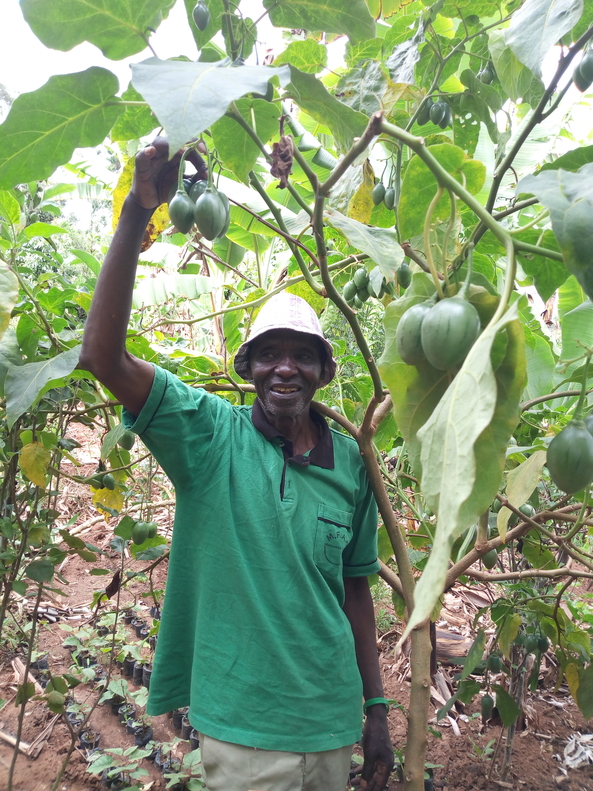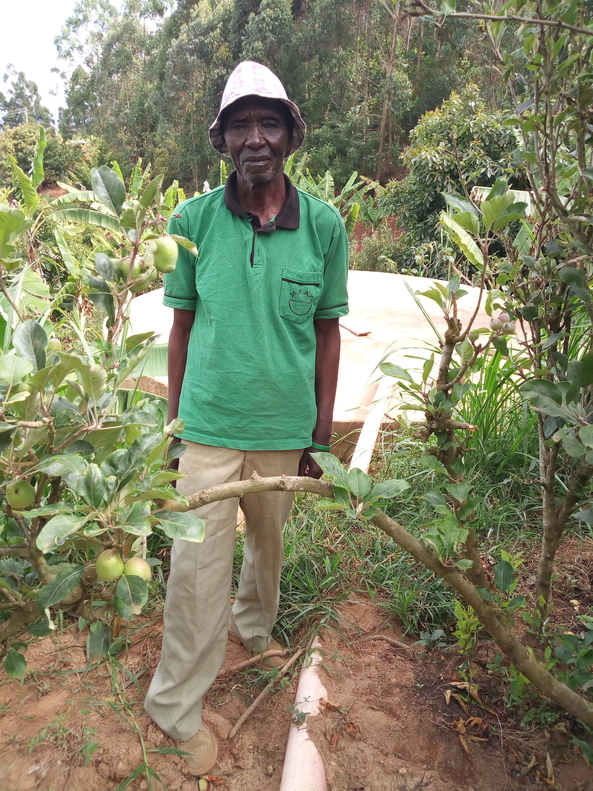 Muia Kusenga,84, showing his tree tomato fruits in his farm. He has been practicing water harvesting for his crop production. Photo: Oyugi Zablon/Farmbiz Africa.
Muia Kusenga,84, showing his tree tomato fruits in his farm. He has been practicing water harvesting for his crop production. Photo: Oyugi Zablon/Farmbiz Africa.
An 84 years old farmer from Machakos County who has mastered the art of water harvesting is able to grow and water his crops all year round while his peers who are only relying on rainfall suffer loses during dry periods.
Muia Kusenga who is a retired colonial government agriculture extension officer started fruit farming over ten years ago but the fruits could dry up during drought something which evoked the skills he had and stated tapping run away water from the roads for future use.
“In this area we always face severe drought between late December and March every year. During this time most farmers lose their crops to drought while others totally stop production. This is why I have been using my water harvesting knowledge to tap enough water for my crops all seasons,” said Kusenga.
His farm has a big underground water tank measuring 12 feet deep by seven metres wide with a capacity of 20,000 litres and can store water for irrigation for more than three months. He has also dug more than 10 trenches in his farm with some leading run-off water from the roads to the tank while others hold the water from wasting away.
“This is not just soil, but rich nutrient silt from for my grapes, loquats, avocados, goose berries, among other fruits. Even if the rains disappear for one to months from June, I will be safe for another three months with irrigation from the trenches and the tank water,” he said.
RELATED STORY: Water harvesting improves Njoro framer’s produce, earns him international award
Numerous taps are strategically installed in his farm to deliver the water from the tank after the reservoirs are depleted. It is interesting that crops like yams, which require a lot of water to survive, are thriving in Kusenga’s farm.
Besides water collection, Kusenga harvests fertile silt, which accumulates in the trenches which are six-by-three feet, from the cuplike depression at the base.
“When the trenches run dry, I collect the silt then add it to the soil. It is my fertiliser. Organic matters collected decompose into manure,” he said.

Muia standing nest to his unerdground water storage tank. Photo: Oyugi Zablon/Farmbiz Africa.
RELATED STORY: Agro-company launches portable water harvesting and storage tanks
Other farmers who come from the same area who have been relying on rainfall to cultivate their crops have been recording losses while others resort to other ventures such as beekeeping to remain relevant.
Zipporah Nzula, one such farmer who lost her quarter acre farm of cassava to drought last year has ventured in beekeeping and poultry to avoid pangs of drought.
“Although I grow some vegetables during rainy seasons, I have decided to major in honey and poultry production which still earn me good money,” said Zipporah.
Angeline Katuku, a dairy and poultry farmer in the same area says that lack of enough water during dry season always lowers her cows’ milk production. “During rains, my three cows produce between 20 and 28 letres of milk each per day but this reduces to between 10-15 litres during dry seasons due to reduced pasture and I have no water to irrigate my fodder grass.”
RELATED STORY: School fights drought with low cost water harvesting model
So far, Kusenga’s farm has become a model where other farmers and experts come to learn water harvesting techniques. Every year the farm is visited by over 500 people who come to learn and buy some of his grafted fruit seedlings.
The farmer has over 50 different varieties of fruit seedlings in his five acres piece of land.
















Comments powered by CComment